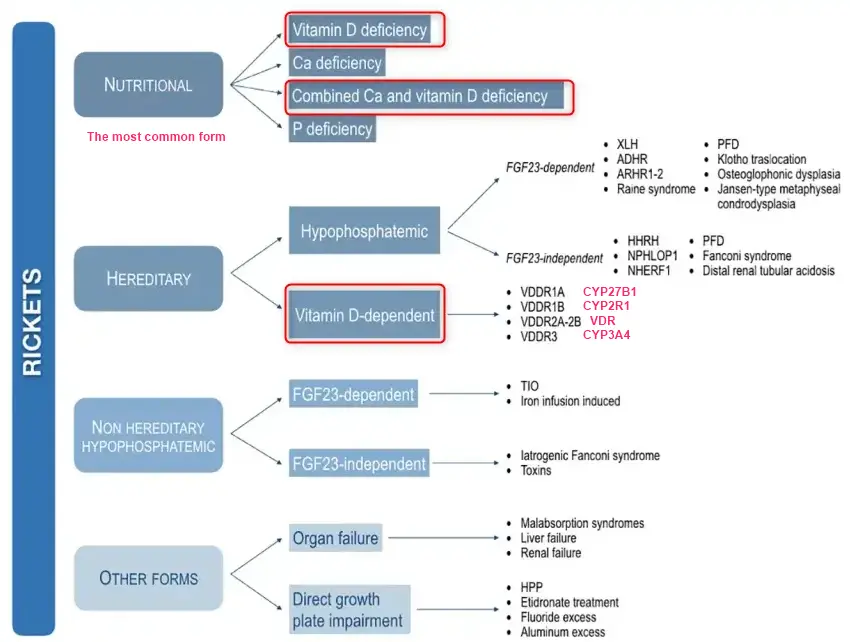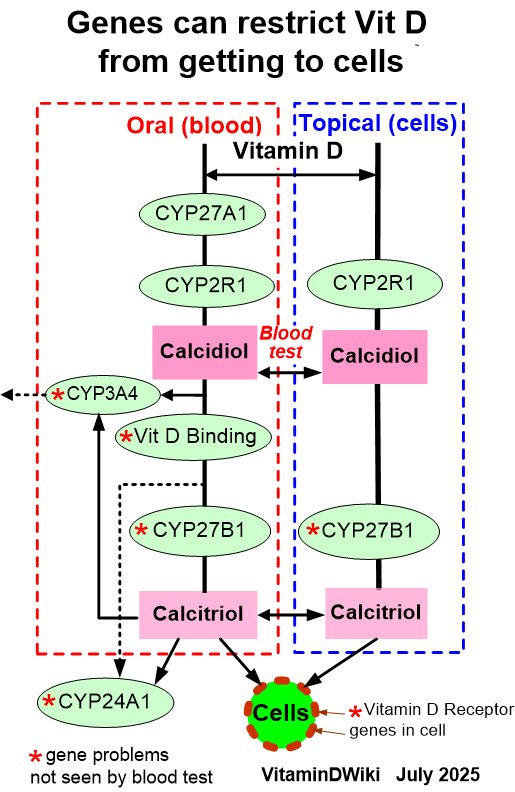Rickets is typically due to little Vitamin D getting the cells

Diagnosis, treatment, and management of rickets: a position statement from the Bone and Mineral Metabolism Group of the Italian Society of Pediatric Endocrinology and Diabetology
Front Endocrinol (Lausanne) . 2024 Apr 19:15:1383681. doi: 10.3389/fendo.2024.1383681
Giampiero I Baroncelli # 1, Pasquale Comberiati # 1 2, Tommaso Aversa 3 4, Federico Baronio 5, Alessandra Cassio 5 6, Mariangela Chiarito 7, Mirna Cosci O di Coscio 1, Luisa De Sanctis 8, Natascia Di Iorgi 9 10, Maria Felicia Faienza 7, Danilo Fintini 11, Roberto Franceschi 12, Mila Kalapurackal 13, Silvia Longhi 13, Michela Mariani 11, Marco Pitea 14, Andrea Secco 15, Daniele Tessaris 8, Francesco Vierucci 16, Malgorzata Wasniewska 3, Giovanna Weber 14, Stefano Mora 17 Italy

Rickets results from impaired mineralization of growing bone due to alterations in calcium and phosphate homeostasis. Clinical signs of rickets are related to the age of the patient, the duration of the disease, and the underlying disorder. The most common signs of rickets are swelling of the wrists, knees or ankles, bowing of the legs (knock-knees, outward bowing, or both) and inability to walk. However, clinical features alone cannot differentiate between the various forms of rickets. Rickets includes a heterogeneous group of acquired and inherited diseases. Nutritional rickets is due to a deficiency of vitamin D, dietary calcium or phosphate. Mutations in genes responsible for vitamin D metabolism or function, the production or breakdown of fibroblast growth factor 23, renal phosphate regulation, or bone mineralization can lead to the hereditary form of rickets. This position paper reviews the relevant literature and presents the expertise of the Bone and Mineral Metabolism Group of the Italian Society of Pediatric Endocrinology and Diabetology (SIEDP). The aim of this document is to provide practical guidance to specialists and healthcare professionals on the main criteria for diagnosis, treatment, and management of patients with rickets. The various forms of rickets are discussed, and detailed references for the discussion of each form are provided. Algorithms to guide the diagnostic approach and recommendations to manage patients with rare forms of hereditary rickets are proposed.
📄 Download the PDF from Vitamin D Life
Rickets Genes and Genetics chart from Vitamin D Life


Note: <13% of Genetic causes of rickets are due to Vitamin D genes (Perplexity AI)
Vitamin D Life – Overview of Rickets and vitamin D contains
{include}
{include}
